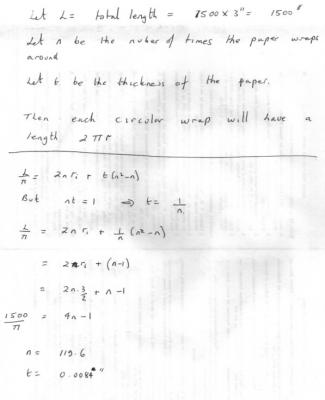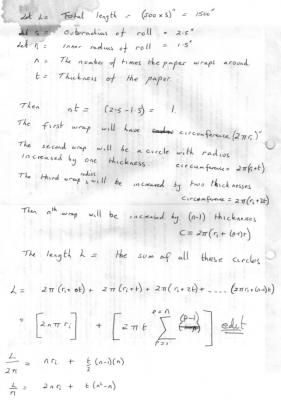-
Posts
17639 -
Joined
-
Last visited
-
Days Won
93
Content Type
Profiles
Forums
Events
Everything posted by studiot
-
OK I now have 8thou after arithmetic correction by my series method, which is really also quite simple. Since imatfaal has posted a valid method (I like it +1) here is mine.
-
I said others were interested. It is a good problem, admitting of many methods of attack. How did your numbers work out imatfaal?
-
This question has interested others, but I can't post a full solution until after your deadline. I made the thickness 0.00627 inches and the number of wraps 159.48, but of course my arithmetic is notedly fickle. I can however help you further to develop a solution, though I can see you are a thinking sort of student who like to do for himself where possible. So ask as many question as you like. How are you getting on putting my post#4 formulae into an equation? You will need to know what the sum to n terms for the natural or counting numbers is 1 + 2 + 3 + 4 +...............n = 1/2n(n+1) So the sum of the first six terms is 1+2+3+4+5+6 = 0.5(6)(7) = 21 Do you understand summing series? You will need to make a slight adjustment to the above to allow for the fact that we are starting at zero not 1 Can you do this? Ask if you need help here.
-
I should perhaps note that the shape is not a true spiral. The first time the paper is wrapped round it is wrapped round a perfect circle since it touches the circular inner tube all the way round. Where is come back to its start point the paper suddenly increases its radius by exactly one thickness of paper and again transits round in a perfect circle. and so on. We can, of course, form a second equation connecting the number of wraps or circles (n) and the paper thickness (t) since each thickness is stacked side by side between the inner and outer radii of the paper. We thus have two equations connecting n and t and can therefore solve them. Please note the area of the paper is not relevent to this exercise. It is the lenght that matters. Of course the number of sheets times the sheet length still equals the total length.
-

Quick help with MOSFETS, where do the electrons come from?
studiot replied to CasualKilla's topic in Engineering
Strong opinions. I think I'll just rest on my Zimmer Frame for now. You were obviously too tired to bother to look it up whilst you were resting on yours. For the benefit of those, less rude, who might also like to know. Charge carriers respond differently to force fields when in solids than they do when in a vacuum. The constant of proportionality between force and apparent aceleration is called effective mass. For electrons this is still usually positive. But for holes it can be positive or negative. (and yes holes act as if they were massive objects) -
If r is the radius of the inner tube then its circumference is [math]2\pi \left( r \right)[/math] After the first time we have wrapped the paper, of thickness t, once round it completely the new circumference is [math]2\pi \left( {r + t} \right)[/math] So the second time we wrap the paper completely round its length is [math]2\pi \left( r \right) + 2\pi \left( {r + t} \right)[/math] The third time we wrap around the circumference has grown again to [math]2\pi \left( {r + 2t} \right)[/math] So the length of paper is [math]2\pi \left( r \right) + 2\pi \left( {r + t} \right) + 2\pi \left( {r + 2t} \right)[/math] So if we wrap around n times the circumference is edit [math]2\pi \left( {r + \left( {n - 1} \right)t} \right)[/math] If you develop this it will give you a formula for the length of the paper in terms of the thickness and the number of whole wraps around. Sorry had to edit the LaTex This may be an 11th grade sum, I don't know your system.
-
Hello and welcome, handsonic. No it is fine to post here any sort of technical question. But surely this is beyond 11th grade? What you are asking is the length of part of a spiral. Can you see that the paper forms a spiral round the inner tube with total length equal to the number of sheets times the length of a sheet? Can you tell us what sort of approximate methods you can use to find and answer? PS Is this really 11th grade homework or a challenge of some sort?
-
Both right. Just to add the system is closed because no matter (mass ) leaves or enters. So work and/or heat are exchanged with the surroundings and our goal is to evaluate each, bearing in mind that these exchanges take place at constant temperature. We are told that the gas expands So what changes and which way is any work 'exchanged' ie what does work on what? Once that is decided we can find a formula to calculate the value of that work, if any. If we expanded a gas what would normally happen to the temperature of that gas?
-
REad through your equation and ask yourself What does it say in words? Never mind the numbers (stochiometry) for the moment. Just what is happening. Something along the lines of ___?___combines with _____?____ in the presence of _____?_____ And I hope we are now agreed that combines with oxygen = burns.
-
Down the pub? Did you look at my link first?
-
Was it so long ago? I asked you what an open system was. Swansont asked you what isothermal meant. Both are mentioned in your set question.
-
Remember this is your title to the thread, not mine. I don't see any carbon in this. So what burns? Hint I could set light to it with a match and it used to be a component of town or producer gas, before the days of natural gas. http://en.wikipedia.org/wiki/Producer_gas
-
The answers to all your questions were in my post #7. Multiplying through by 100 was just meant to make life easy for you. So after a good laugh at your joke, what burns?
-
So what happened to my post#7? Did I waste my time?
-
The question also told you that But you have made no attempt to use this information. So I'm quite sure that either your lecturers or your tutor gave you much more information than you seem willing to let on. Yes the equation you quote (from your lecturer) is appropriate, but only when you understand what you are doing and we have some way to go to reach that stage. So just please try to answer my simple questions and swansont's and don't offer any additional information. This trail will eventually lead to the answer you need.
-
Does it? I thought it stated that the change in internal energy = the sum of the work done and the heat exchanged dU = q + w or dU = q - w, depending upon your sign convention. Can we discuss the problem in these terms since that is what your lecturers are expecting?
-
Here is a hint. This question is about the first law of thermodynamics. Can you at least state what that is so we can take it further?
-
Since when did they start measuring volume in kilograms? Why can you not simply answer the questions swansont and I asked? They are very simple and very basic and will lead you to the correct answers.
-
You joined at 1804 today and you had posted 19 homework questions by 1814, when you left. Is this a record at one every 30 seconds? The price is £1,000,000 payable in advance.
-
So start by following swansont's advice. Actually this is good advice for all physics questions (He was a physics teacher after all) List what you know. Then list a few things you don't know, but might like to. So What is a closed system, why did they specify one? If the question also specifies work can pass the boundary, what else can and can't? What formulae do you know connecting these things? I am going to cut the grass now, but I will look in for a cup of tea and to see how you are getting on, from time to time.
-
If you can do the 'calculations', why do you 'need the formulae' ? Which formulae? As I see it, this question is testing your understanding, not your arithmetic so explain what is happening.
-

Are mathematical constants equivalent to Infinity?
studiot replied to Mr. Astrophysicist's topic in Applied Mathematics
Who said it was undefined? It may be that it is not calculable. That would be the case with your example since we don't know what a and b are and their relationship. 'Some number' is correct, but that number is not fixed since there are many different infinities and 'some number' will be different depending upon the circumstances. -
+1 each for good communications. I strongly suggest you don't use fractions or decimals in chemical equations (for balancing). Multiply through by 100 first. Each coefficient ie supposed to stand for one molecule (or 1 gram mole or 1 kgmole). As to pavel's second helpful question. You have (correctly) called this a combustion process. Combustion is combining with oxygen (oxidation). So what burns?
-

Are mathematical constants equivalent to Infinity?
studiot replied to Mr. Astrophysicist's topic in Applied Mathematics
Just to take up this point a little further. We discussed in your other threads that things in general and infinity in particular have 'properties'. Properties are the means by which things interact with other things. They are the means by which we can observe and perhaps measure this interaction. Observing one particular property does not in general say anthing about another and different property. With particular regard to infinity. One property is that it can be considered in some sense 'going on forever'. This property is what we talk about when we take limits and think of the relationship between infinity and ordinary numbers. The idea that if N is an integer, there is always an integer (N+1) bigger than N and you can go on adding N forever. That is you never get to the end of the process. But this is an inconvenient property and for some purposes we consider the entire sequence is finished and present. We do this for projective geometry - the point or line at infinity is always there, not somethign we can never reach. We do this for the different properties that ajb mentioned on the extended number line. We do this for a whole theory of different infinities or different properties of infinity. These properties are not necessarily transferable so don't mix them up. -
Careful. We are applying some rules of some of mathematics. If what you said in post 21 was completely valid then what about an alternative rearrangement of the equation, such as I offered in post#5, that does not lead to a contradiction ? This view, of course, leads to an alternative view of infinity.



